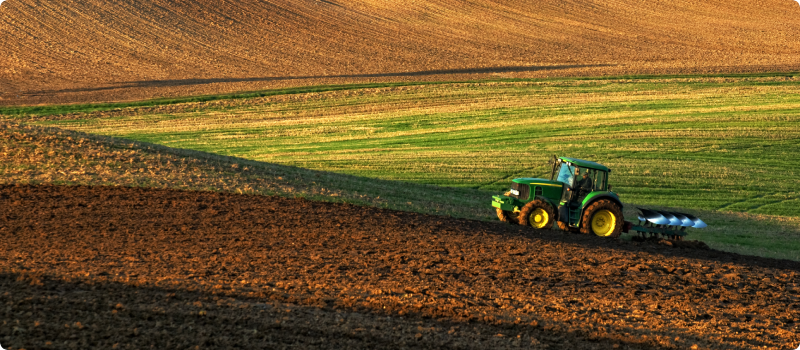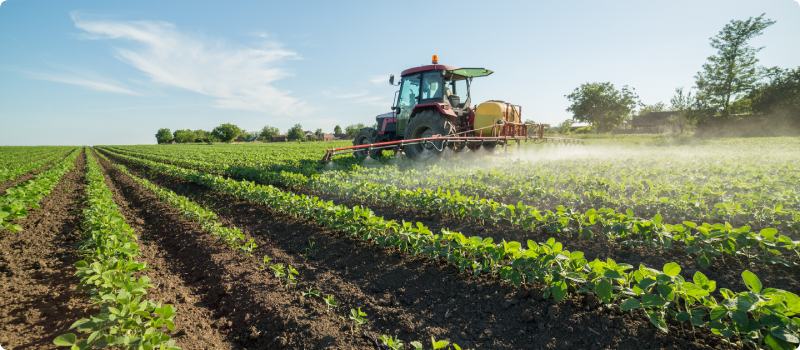How to Find Farmland for Rent
Updated February 28, 2024 . AmFam Team
As a farmer looking for land to rent, you may have to do some research to find a landowner willing to lease out their land for farming. Land and farm owners can be skeptical of farmers they don’t know for many reasons. But if you look in the right places, and find the right lease agreement that works for both land owner and renter, you may find the acreage you need and make a healthy profit doing so.
We’ll explore what it takes to get a tract of land rented and look at all the other variables you need to consider when renting farmland real estate, like lease types and liability coverage. Take a look at these important tips on how to get the acreage you need for a productive season.
How to Find a Landowner to Rent Land From
Whether you’re a new farmer or an experienced ag veteran seeking to expand your operation, you’ll need to work with current landowners and prove you’ve got what it takes — to be a good custodian of their land — and that you’re able to turn a profit too. There are a lot of different ways to go about renting and leasing. Here are a few ways to locate farmland and owners who are willing to lease you land:
Learn About the Beginning Farmer Tax Credit Program in Iowa
The BTFCP incentive (Opens in a new tab) provides Iowa residents a tax credit for agricultural asset owners to lease their land, equipment and/or buildings to beginning farmers.
Check Farm Link Online
The Farmland Information Center (Opens in a new tab) is a federal program acting as a “clearinghouse for information about farmland protection and stewardship.” They’re a great nonprofit resource for beginning farmers.
Look for Farm Incubators
Incubator programs may allow new farmers a short-term lease opportunity and offer training and farm business management classes. Graduates of these programs receive placement assistance.
Search Farmland for Lease-to-Own Opportunities
When retiring farmers won’t be handing down their farm to the next generation, they may be willing to enter into a lease-to-own agreement. You’ll craft a lease that spans several years with an option to buy at the end of that period.

Understand Your Farmland-Leasing Options
Farmers and ranchers seeking land have many leasing options for renting tillable acreage or pasture for livestock. Depending on the type of lease agreement you settle on, you may either rent outright or pay the landowner a share of the profits made from the venture. The National Agricultural Law Center has a great article that provides an overview of agricultural leases (Opens in a new tab).
Fixed Cash Lease
This is a set payment agreement that’s made up-front and does not allow for adjustment based on yield, market prices or crop production. This option puts all the risk onto the shoulders of the renter, as the landowner isn’t dependent on productivity for payment. Tenants can really benefit when the weather and other factors cooperate all season long.
Custom Farming Agreement
Custom farming agreements are an alternative to leasing farmland. In this case, the renting farmer, or “custom operator” provides all equipment for fertilizing, planting, harvesting and labor and are paid a fixed rate per acre for completing each activity.
According to Iowa State University’s Extension and Outreach program (Opens in a new tab), “the custom operator agrees to perform all the machine operations on the owner’s land in exchange for a set fee or rate. The landowner pays for all seed, chemicals, and other inputs, and keeps all of the crop and commodity payments.”
Crop Share Lease
The design of this lease structure bases payment on the crop produced on the farm. The landowner is paid in grain and is responsible for grain marketing. Crop share leases generally fall into two categories:
80/20 or 75/25 Modified Crop Share
This lease includes the landowner purchasing all of the inputs and the farmer provides the knowledge and operations to produce the crop. The landowner is then paid with 80% or 75% of the crop and the farmer receives 20% or 25% of the produced grain. This is similar to a custom farming arrangement, but instead of paying the farmer cash for operations, they receive a share of the grain.
Two-Thirds Crop Share
In this agreement, the farmer covers the costs of inputs but reaps the reward of two-thirds of the total yield. The landowner, or renter is paid one-third of the yield.
Lease to Own
This is a great ‘try before you buy’ option for farmers who don’t have the finances to purchase the property outright. It’s essentially an extended purchase agreement with all the caveats and restrictions found in a conventional purchase. They can be either long or short-term in nature. Some commercial lenders will extend credit to long-term leaseholders, particularly when the lease allows the tenant to build on the property.

Flex Leases Offer Risk and Reward
Flex leases are one way for landowners and farmers to share in the land's risk and profit opportunities. Here’s a summary of popular flex leases:
Flex Lease
In a flex lease the landowner is paid in cash, but the payment is tied in some way the performance of the farm in a given year. The Flex lease was designed to ease the burden of a landowner marketing their grain, while also sharing some of the risk with the farmer. Flex leases take many different forms, but some of the most popular are:
Yield Index Lease
This flexible lease type determines the amount of rent to be paid each year based on the actual yield. Here, both renter and landowner share a burden of risk.
Price Index Lease
Rent costs for this lease are determined by the difference in year-to-year commodity pricing. When costs are consistent from one year to the next, that stability can reduce risk to the landowner and they may be more likely to agree to this lease type.
Gross Revenue Lease
Rent paid at the end of the year based on the actual yield multiplied by the actual price of corn. 35% - 40% of that resulting figure is then paid as rent to the landowner.
Basing rent off of a percent of the gross crop income for a given year, this option offers a more consistent payout over the years for the tenant. That’s because the rent adjusts up or down with both yields and pricing. Landowners may find rent prices fluctuating when annual rates vary significantly.
Base Plus Bonus Lease
Another flexible rental price lease, this option allows the landowner to specify a base price for a crop and adds an additional percent due when the yield produces a profit above the stated base. The bonus is often calculated using one of the methods outlined above.

The Importance of Insurance When Leasing Land
Because most lease agreements place risk and financial gain on both landlord and the leasing farmer, each party should insure carefully. A good commercial general liability insurance policy can go a long way in the event of a bodily injury, damage to property of others, or accidents.
In fact, sample lease agreements from the University of Illinois Extension (Opens in a new tab) and Iowa State University’s Extension and Outreach program (Opens in a new tab) require insurance to be active and maintained across the term of the agreement.
Note that if the tenant and the landlord both work with the same insurance company, they may have a better chance at finding complete coverage for their operation. Here are other reasons why insurance when leasing is so important:
Tenant Personal Property Coverage
Similar to a typical renters insurance policy, leasing farmers will need a policy to cover their tools, equipment, liability and personal effects stored or used on the leased property.
Peak Season Insurance Protects Your Inventory
This key coverage can help you manage the spike in value of your operation prior to planting and right after harvesting.
Finding land to rent out can be a challenge for new and experienced farmers, but when you do locate tillable acreage, remember to reach out to your American Family Insurance agent. They’re experts at crafting an insurance policy that meets the demands of your leased land operation and will help you to cover everything to minimize losses and maximize profits.
This article is for informational purposes only and based on information that is widely available. This information does not, and is not intended to, constitute legal or financial advice. You should contact a professional for advice specific to your situation.
Tools & Resources
NextScripts
JSS component is missing React implementation. See the developer console for more information.

